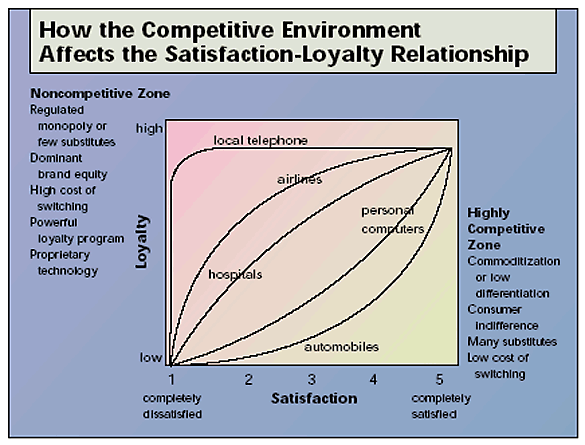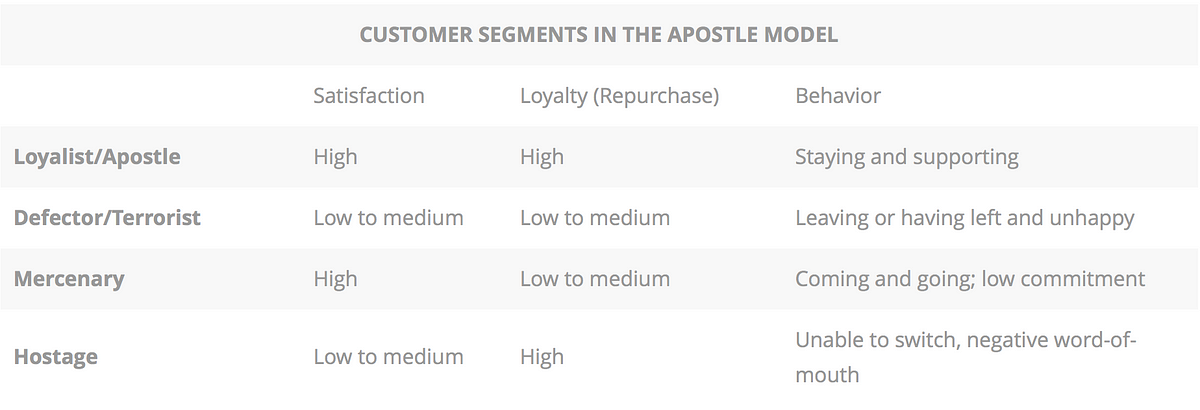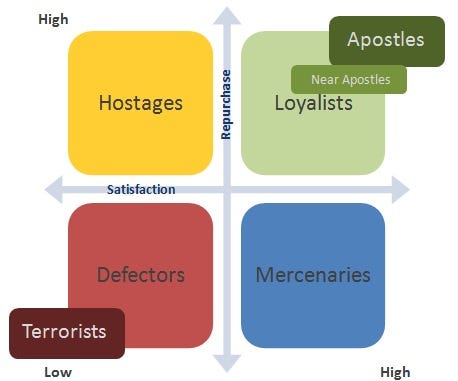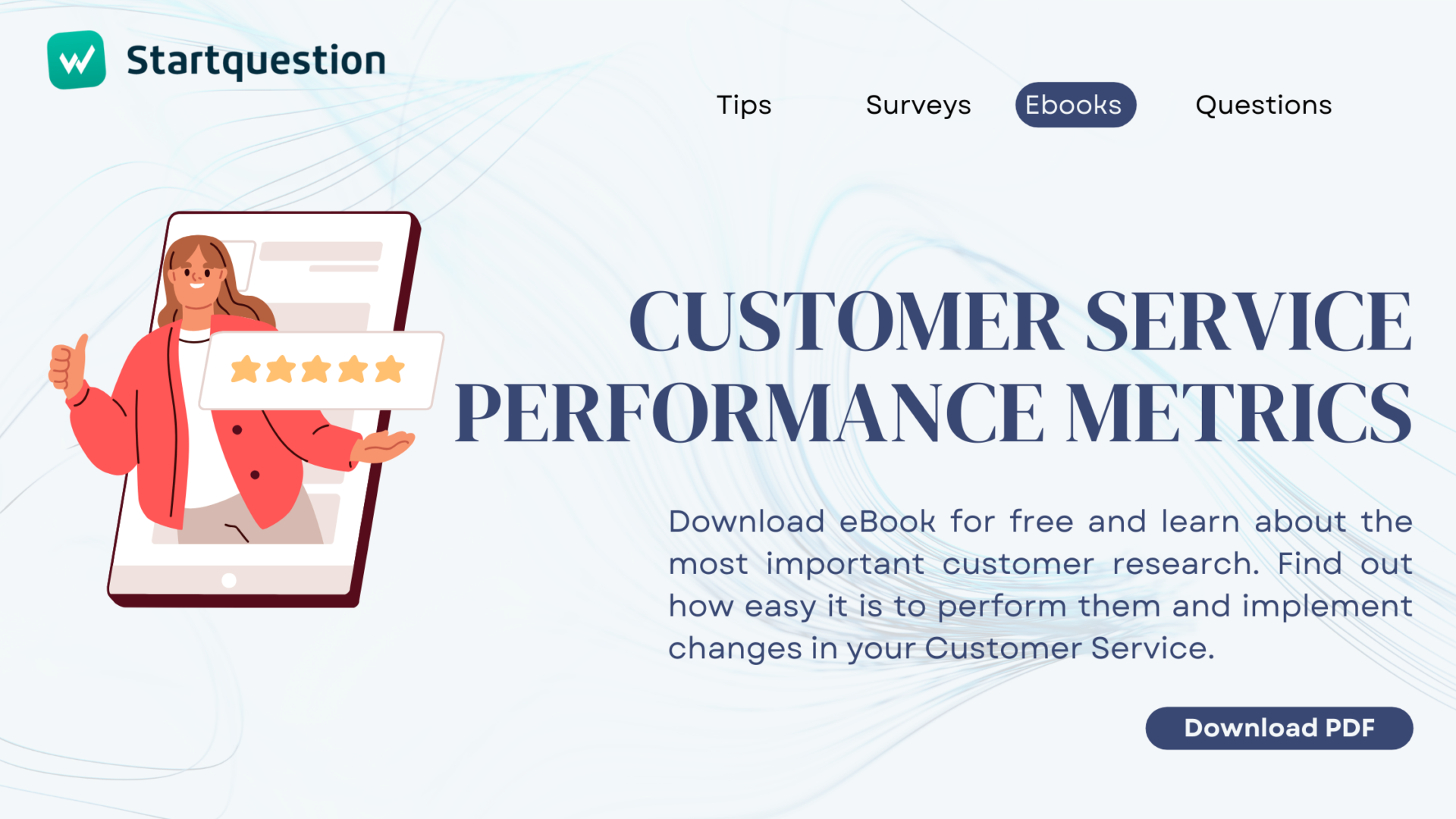In the perfect world, your business would have only satisfied customers who always buy your products and spread positive word-of-mouth among friends. Unfortunately, the reality is not as colorful as business owners would like it to be. Today’s consumers are more demanding and it is not easy anymore to completely satisfy them. What’s more, it comes even harder for marketers to transform them into loyal clients who would support brands.
Customer loyalty is a crucial factor that has a profound effect on the growth and success of your business. Therefore, a customer-centric approach that puts your customer first, at the core of your business helps companies to achieve better results. This strategy can give you a competitive advantage on the market and help you gain priceless brand ambassadors who would praise your products for you. However, you need to understand your customers, their behavior and adjust marketing communication depending on who you deal with.
Startquestion is a survey software
Gather feedback via weblink, social media, email, and more.
No credit card required · Cancel any time · GDRP Compilant
There are numerous frameworks that try to conceptualize customer loyalty. In this entry I want to discuss the Apostle model that was developed at Harvard Business School. It uses two dimensions to describe the level of customer loyalty. That approach takes into consideration two important factors that determine loyalty: overall satisfaction and likelihood to repurchase. These components enable you to divide your customers into four groups that should vary in terms of customer approach and communication. This framework can be a starting point at developing an effective strategy for customer communication management.
Customer loyalty and satisfaction defined
Customer loyalty and satisfaction are very close terms, one is related to the other. However, they are not equivalent. Customer loyalty is a bigger concept and partially stems from overall satisfaction that basically describes to what extent a specific need is fulfilled by a product or service. Loyalty, on the other hand, is a the feeling of attachment to or affection for a company’s people, products, or services. Such feelings are reflected in customer behavior.
Numerous studies have shown a positive correlation between customer satisfaction and customer retention and loyalty. If a customer is happy with a product and service he or she will be more willing to repurchase and recommend it in the future. However, Harvard studies have discovered that the correlation between satisfaction and loyalty is not linear. Naturally, it also depends on the market situation. In the case of monopoly (e.g. electrical utilities), where customers have no choice, their loyalty is less sensitive to their overall satisfaction. On the other hand, in highly competitive markets, customers who are completely satisfied with service will be much more loyal than merely satisfied customers (see the graph below). It indicates that upgrading customers from “nearly satisfied” to “completely satisfied” will affect in a much bigger rise in customer loyalty.
Ready-to-use examples of customer surveys
What does it mean in practice? Investing your time and resources in customers who are just satisfied will bring you a tremendous improvement in the level of loyalty. On top of that, remember that it cost a couple of times more to recruit a new customer than it does to retain one. However, before I discuss how to manage customers of distinct levels of loyalty, let me first introduce you to the Apostle model.

From Apostles to Terrorists
Without a profound comprehension of customer attitude and their behavior, your business might not have a chance in a highly competitive market. However, understanding your clients as a group instead of individuals is not enough to get a competitive advantage. That’s why consumer segmentation based on unique behavioral attributes, the intensity of satisfaction or dissatisfaction (attitude), and ability to act on their satisfaction or dissatisfaction (competitive market dynamics) is critical in managing their loyalty.

When you consider the variables mentioned above, all your customers will fall into one of categories: loyalists, defectors, mercenaries, or hostages. Each category is characterized by different loyalty behavior (table “Customer Segments in the Apostle model”). Let’s get a closer look at all of them.

Loyalists– this group is made up of customers who are satisfied or completely satisfied. They also buys a product from you repeatedly and stay loyal. They are one of the most valuable assets you can earn, as not only they guarantee your company gets regular revenues, but also they spread a positive word about your brand, giving you a free and genuine advertisement.
- Near Apostles are almost as satisfied and loyal as Apostles, but they need something more.
Mercenaries are satisfied customers, but they switch between brands. They are usually price-sensitive, looking for bargains and best offers, buying on impulse, pursuing fashion trends. They don’t feel any attachment to particular brands. They are usually expensive to acquire and difficult to keep.
Hostages are not satisfied, but they keep repurchasing from your company. Why? They are usually stuck with a company because of a monopoly situation on the market or high switching costs. They may easily turn into defectors.
Defectors are probably the biggest nuisance to your company. They are neither satisfied nor loyal and very often spread negative word-of-mouth about your brand, ruining your reputation.
- Terrorists fall into Defectors’ segment. They are customers who had a bad experience with your brand (not necessarily because of your fault) and they don’t hesitate to publicly complain about it.
Dividing your customers into four separate segments depending on their loyalty is a good way to get a better understanding of your clients and consequently to learn how to manage them. You should apply a different approach to loyalists a different one to hostages. Thanks to proper communication, not only can you improve the loyalty of your customers, but also transform negative complainers into brand ambassadors!
How to leverage customers in every segment
Before you start designing your communication strategy you should learn how to prioritize addressing different segments. As I mentioned above, keeping a current customer can be multiple times less expensive than acquiring a new one. Unless you have unlimited resources you should locate your forces efficiently.
1. Address Defectors and Terrorist first
Never, ever ignore dissatisfied customers. It doesn’t mean you always have to fix their problem from top to bottom at once, but never leave their complaint unanswered. Negative feedback might spread quickly giving your company a bad name. You should react as soon as possible depriving haters of grumbling.
There is another good reason you should be responsive to Defectors. Their negative experience are often related to very strong emotions. They might be angry because of customer service or a product that doesn’t match expectations. However, once you help them fix an issue negative emotions might be transformed into positive ones, and a Terrorist may become your Apostle. In many situations, it’s easier to invert emotions than stoke them at the indifferent person.
2. Appreciate Loyalists and Apostles
Still, many practitioners get the wrong idea of customer acquisition and think that once they close a deal and satisfy customer needs they can hunt for other clients. Wrong! You should nurture relationships with your customers especially when they are devoted to your brand. Appreciate their loyalty and always go the extra mile for them in customer service. They will repay you with positive word-of-mouth enhancing your earned channels.
On top of that, remember that a small improvement in the satisfaction of already satisfied customers affects a significant change in loyalty. Therefore, if you offer an extra value to the satisfied customer you can at a low cost and effort gain valuable brand ambassador.
Finally, Apostles who actively praise your brand deserve special treatment. Why? They put their own reputation at risk recommending your business. They put full trust in your company, so not only should you do your best not to fail them, but also you should reward such behavior.
3. Don’t ignore Hostages
Whether a Hostage sticks with you voluntarily or a current market situation forces him or her to do so, don’t forget about them. It will require more effort to improve their satisfaction, but you don’t want to lose them. The market situation or their will might change and they will defect to your competitors or, what’s even worst, they will become Terrorists. Do your best to understand their needs, reasons for dissatisfaction, and work through it with them. Appropriate communication is a key retention strategy for this segment. The rule “it’s cheaper to retain a customer than acquire a new one” also applies here.
However, don’t try to retain hostages by all means. If they are not satisfied with your brand offer they might be not in the target group. As I mentioned, try to understand their expectation and verify if you can fulfill them. If they don’t match your value proposition and you are not willing to alter it, let them go.
4. You can’t have much control over Mercenaries
Mercenaries do not pose a threat to your brand reputation, but they are not of a big value to your company. You can completely satisfy all their needs and still, they will show no loyalty towards your brand. They don’t pay much attention to brand attributes and don’t get attached to a product they use. They will switch between different options, seeking better prices or change for the sake of change. There is not much you can do to retain them, but don’t forget to communicate the benefits your brand offers. Keep your message consistent, but don’t spend too much time dealing with them. You will need as much effort to please them as to please long-term loyal customers, but the relationship with Mercenaries will not bring you much profit.
Find ways to listen to your audience & increase customer loyalty
Your customers are the best source for information about how your business is doing right now and where it should head for in the future. Their feedback constitutes a valuable insight about your brand, product, and services. If your strategy to manage their satisfaction and loyalty is supposed to succeed you need to be able to listen to them.
Some of your clients might directly address you with their feedback, but this slight number will not give you a big picture. You should know the methods to gather information about clients and learn how to leverage it in your strategy. Only a proactive attitude gives you an opportunity to improve.
This topic area might be a good material for another article, but I want to just briefly introduce the main ways to listen to your audience.
- Measure customer loyalty using Net Promoter Score index. NPS is based on one simple question that predicts the likelihood of both repurchase and referral: “How likely is it that you would recommend this company to a friend or colleague?”. Your customers will respond on 11-point scale (0–10). Not only will this question help you get feedback on what’s working well in your business and what you still need to improve, but also you will be able to effectively measure and manage customer loyalty. On top of that, it’s a good indicator that shows relation between customer loyalty and business growth rate.
- Give space and incentives to your customers to leave their feedback on the owned channels (website, social media pages, helpline). Make sure that if they want to make a complaint or praise your brand they will easily find a place to do that.
- Use Internet monitoring for collecting mentions about your brand. People leave a lot of information online and thanks to social listening tools you can collect mentions that are crucial to your business, analyze them and appropriately react to them.
- Conduct market research regularly as it is also a valuable source for customer insights. You can conduct different types of studies, applying distinct methods.
- Be always up-to-date with information that customer service staff report. Employees who interact with customers on daily basis are the ones who should have a profound understanding of customer problems. They should be trained and well-prepared to deal with distinct types of clients and able to listen to them.
The Apostle model is one of many strategies you can test out in customer loyalty management. Like any other model, it has its advantages and flaws. The best way to find out if it works for you is to try it. Whether you apply this approach or you find another one that is a better match for your business a key to organization success is a focus on customers and their satisfaction. You must understand their needs, behavior and learn how to address distinct kinds of people in your customer portfolio.
Good luck!




